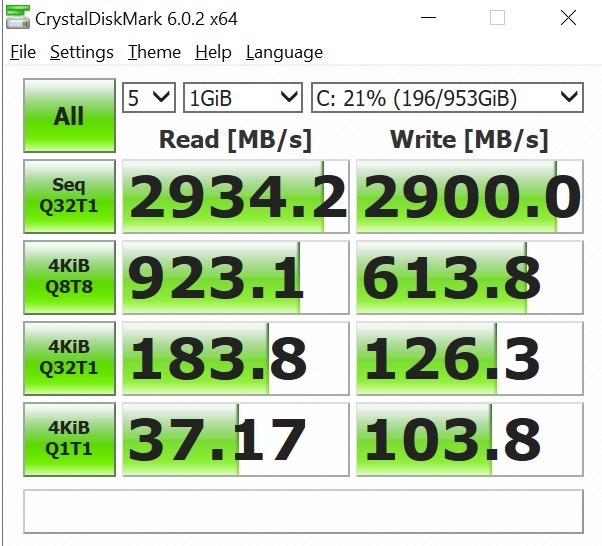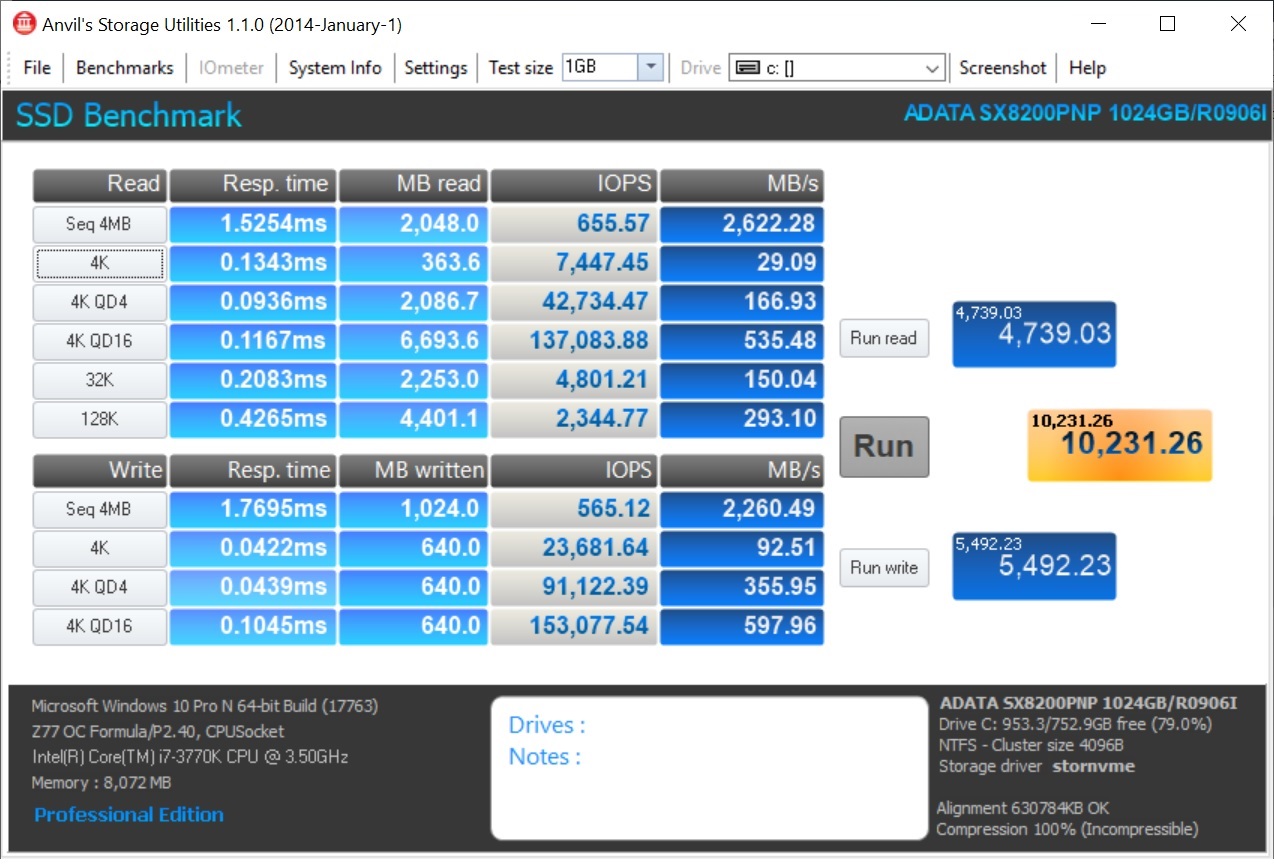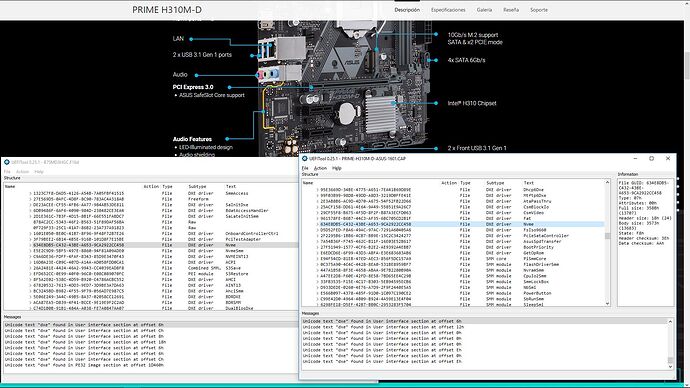@Andrey_Aleks :
Who gave you the advice to clone your previouly used system drive to the NVMe SSD?
As you can read within the start post of this thread, you should do a clean install of Win10.
@Fernando
I apologize for not writing correctly, I installed a clean Win 10 on a simple SSD,since there is no key on Win 10, an upgrade is made from Win 7 to Win 10.
I transferred Win 10 to the SSD NVMe drive using the IntelDataMigration program, but when I transferred the programm shared the NVD SSD drive in such a way as I wrote earlier.
And Win 10 on the SSD NVM disk immediately started up all right and activated, which was what I needed activation, but immediately decided to check the clean installation.
On the SSD NVMe drive, but the Win 10 installer did the SSD NVMe distribution a little differently and the download failed successfully.
@Andrey_Aleks :
As I already have written, you should do a clean install of Win10 in UEFI mode onto the NVMe SSD according to my guide (= start post of this thread). Once the NVMe SSD has been detected by the Win10 Setup, you should let the Setup delete all detected partitions of the SSD and create a new partition for the OS installation. Then everything should work automaticly.
Important: There is no need to enter a Win10 key! Just hit the button “I don’t have a Key” and Win10 will be properly installed nevertheless.
@Fernando @Lost_N_BIOS
After few days analysing about the bios of P5Q Deluxe,I found there was nothing to do with the ssd and system in it.
But the only thing that matters is “CSM” module in the bios.
I compared bios of the Asus P8P67 rev3.1 “ver 2302” with “ver 3207” . “ver 3207” just had the “CSM” module,and it could show “windows boot manager” in the boot section of the bios when plugged nvme SSD,but “ver 2302” just show “PATA”.
There are more things about “ver 3207” such as “PCI ROM Priority” and "CSM support"
http://s000.tinyupload.com/?file_id=23029977308003577320
bios of “ver 3207” .
You can see the “windows boot manager” in the boot section,although “CSM support” was hidden。
http://s000.tinyupload.com/?file_id=00794999501107358181
bios of “ver 2302”
There is only “PATA” in the boot section.
But I got an question about the uefi boot mode of the U disk in the last red frame,and I could enter the GRUB var the U disk!!!
http://s000.tinyupload.com/?file_id=53670833866037642600
Another thing:
ASUS P8P67 was very lucky having csm module is the new bios.
ASUS F1A75-V didn’t had it even in the latest bios “ver 1003” post in the year of 2014!!!(ASUS bias -_-!)
So I think a good way to let the bios of p5q deluxe support nvme SSD is grafting the “CSM support” module from some boards.
Could you help me ? Thaks all~~~
@gloobox :
Nobody is able to boot off a disk drive, which is listed with the name “PATA” within the BOOT section of the BIOS. Nevertheless I am pretty sure, that you will be able to boot off the NVMe SSD.
The entry “Windows Boot Manager” requires the existence of the related UEFI mode boot sector, which is obviously not present on your NVMe SSD, because you haven’t yet tried to install Win10 in UEFI mode onto it.
So please try to get Win10 properly installed in UEFI mode onto your NVMe SSD by booting off an USB Flash Drive, which has been prepared by the Rufus tool according to my guide.
This will not work. You will brick your mainboard by trying to do it.
Actually I had tried the way you tell me using the Rufus tool,but failed.
It only just showed "PATA" but missing the "windows boot manager"
Hello!
I’m first time at this forum and sorry for my bad English.
I want modify BIOS for Gigabyte GA-B75M-D3P to make Samsung 970 Evo NVMe PCIe bootable.
I have
UEFITool.exe alpha 54 (2019-01-07)
b75md3p.f7 - last official BIOS from Gigabyte
NvmExpressDxe_4.ffs lenght 20832 byte
And now some questions:
- I just open b75md3p.f7 in UEFITool.exe? It’s no need to prepare BIOS from vendor any way?
- after opening BIOS UEFITool.exe says:
parseFileHeader: file alignment 10h is greater than parent volume alignment 8h
It’s a crytical error or it’s normal?
- and last ;). I can’t modify BIOS becose all action are unavalable (it’s have grey color).
Why? What’s my mistake?
Thanks!
@ignorant :
Welcome to the Win-RAID Forum!
Who gave you the advice to use an Alpha version of the UEFITool?
If you would have followed my guide, you wouldn’t get the “parseFileHeader” message.
I just have tried the operation by using the latest official UEFITool v0.26.0 and didn’t have any problem.
Regards
Dieter (alias Fernando)
What means “failed”? At which stage of the Rufus work did it fail? Which message did you get?
The “Windows Boot Manager” is missing until you have finished the first part of the Win10 installation in UEFI mode.
After having created the bootable Win10 USB device by using the Rufus tool you have to boot off the USB Flash Drive in UEFI mode! The other entries within the Boot Manager don’t matter!
@Fernando :
Hi, I have the same mobo as @Tunak and I just bought a Samsung 970 Pro and PCIex bracket. Would you please repost the file with the BIOS modded for you for ASUS Z87-PRO. The previous link you posted doesn’t work, download never starts … Thanks a lot !
@Fernando
I’v got Alpha version from https://github.com/LongSoft/UEFITool/releases and this is my main mistake.
There are no problem whith rel. v0.26.0.
Now I have bootable Samsung 970 Evo.
Amazing, but it work :))
THANKS a lot, Fernando!
I’m happy!
Attachment - MOD BIOS for Gigabyte GA-B75M-D3P with NvmExpressDxE_4.
Can your approve my work?
b75md3p_nmve.zip (4.42 MB)
@gtr777 :
Welcome to the Win-RAID Forum!
Why don’t you modify the BIOS yourself? For users like you I have taken the time and written the step-by-step guide (= start post). The BIOS modification is easier than you may think and only by doing it yourself you prevent a new BIOS modding request each time, when the mainboard manufacturer will release in the future a new and hopefully better BIOS version.
The link still works fine. After a double-click onto the attachment the download starts automaticly. I just have checked it.
Regards
Dieter (alias Fernando)
@ignorant :
Thanks for your feedback. It is fine, that you finally succeeded and now can boot off the NVMe SSD.
Conclusion: If someone doesn’t follow my guide and the operation fails, it is a good idea to retry it by following my guide.
Why should I do it, if you already succeeded after having flashed your modded BIOS?
Hi @Fernando ,
In fact I did modified my own after downloading it from Asus support website (pls see attached). However, I saw some BIOSes modded with 3 NVMe modules Nvme. NvmeSmm, NVMEINT13 (like I did mine) or with NvmeExpressDxe_4 (like you did yours). Since I haven’t quite understood the difference I wanted yours as an indication of the path to follow. BTW link finally worked, I think it was my browser, won’t download in Firefox but did download in Edge, go figure ! Thanks a lot !
Haven’t uploaded the file with my previous message
z87-pro-asus-2103-mod.rar (4.72 MB)
For systems without any native NVMe support the insertion of the NvmExpressDxe_4 module is the best choice.
Reasons:
1. The modules named NvmeSmm and NvmeInt13 have no effect on the function and performance of the NVMe Controller.
2. They can be inserted, but have no effect on systems without native NVMe support (integration into the system BIOS is missing).
3. Contrary to many BIOSes with native NVMe support the NvmExpressDxe modules, which are offered within the start post, are newer and do support the latest Nvme protocol version.
Hi Fernando,
Thanks a lot for this amazing tutorial ![]()
I just modded my Z9ped8 ws bios with MMtool
Nvme module just inserted and everythings are fine unless I tried to flash my bios!
EzFlash just show an error which contains „Security verification failed“.
It seems modifying cap file caused invalid signature!
As I know there is no way to have valid signature with such a tool!
So my question is:
Is there any way to have some sort of bin file from cap which is make me able to write it with programmer into bios chip? (I already have a backup chip with original bios installed so it is secure enough to play with programmer on second chip)
So in this case I can bypass security check ![]()
Thanks a lot and have a lovely day
@Sonixax :
Welcome to the Win-RAID Forum!
For users, who have problems to get a modded BIOS properly flashed, I have started >this< specific thread.
Since you obviously have an ASUS mainboard without USB Flashback support, please follow my tips and hints given within the chapter “B. Methods for ASUS mainboards without USB Flashback support”.
If you should have further questions regarding the BIOS flashing procedure, please post them into the linked thread.
Good luck!
Dieter (alias Fernando)
Thanks Fernando - you and the rest of the team who contributed to this are legends !
I followed your very thoroughly documented instructions precisely, and Bingo! … it worked first time ![]() … on first boot, it even automatically finished off my semi-installed Windows 10 installation on the NVMe SSD.
… on first boot, it even automatically finished off my semi-installed Windows 10 installation on the NVMe SSD.
Windows now boots up in 8 seconds.
Kit:
Motherboard: ASRock Z77 OC Formula
EUFI BIOS: v2.40 beta
CPU: Intel Core i7-3770K
NVMe SSD: Adata SX8200 Pro 1TB installed in an Angelbird Wings PX1 add-in card.
Click to enlarge performance benchmarks:
CrystalDiskMark:

Anvil:

… Paradox
